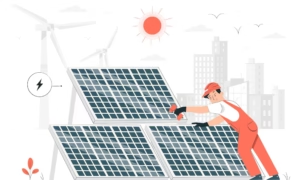
In recent years, sustainability has emerged as a defining factor in construction and design. This shift towards eco-conscious practices has permeated various industries, including architecture and temporary structures. Inflatable domes, once primarily associated with novelty and entertainment, are now at the forefront of sustainable design innovations. This article explores the concept of sustainable solutions in inflatable dome construction, highlighting the environmentally friendly materials, energy-efficient technologies, and green practices that are transforming these structures into eco-conscious marvels.
Eco-Friendly Materials
One of the fundamental pillars of sustainable inflatable dome construction is the use of eco-friendly materials. Traditional dome materials like PVC have raised environmental concerns due to their production processes and disposal challenges. However, modern inflatable domes increasingly incorporate alternative materials, such as recycled PVC or thermoplastic polyurethane (TPU), which have a reduced environmental footprint. These materials can be more easily recycled and are less harmful to the environment during production.
Energy-Efficient HVAC Systems
Heating, ventilation, and air conditioning (HVAC) systems are essential for maintaining comfortable temperatures inside inflatable domes, especially during extreme weather conditions. Sustainable solutions involve the integration of energy-efficient HVAC systems that optimize temperature control while minimizing energy consumption. Some domes utilize heat recovery ventilation to recycle warm air, reducing the need for constant heating.
Solar Power Integration
Solar panels have become a popular addition to inflatable dome designs, particularly for those intended for long-term or off-grid use. These panels harness renewable energy from the sun to power lighting, climate control, and other electrical systems within the dome. Solar-powered inflatable structures significantly reduce their reliance on non-renewable energy sources, making them more sustainable and cost-effective in the long run.
Recyclability and Reusability
Sustainability in inflatable dome construction extends beyond the materials used in the initial build. Manufacturers are increasingly designing domes with ease of disassembly and recyclability in mind. Modular structures allow for individual components to be replaced or upgraded, extending the lifespan of the dome. Additionally, inflatable domes are designed to be portable and reusable, reducing the need for new construction with each event or application.
Sustainable Manufacturing Practices
Sustainability begins at the manufacturing stage. Some inflatable dome manufacturers have adopted sustainable production practices, such as minimizing waste, reducing water usage, and optimizing energy efficiency within their facilities. By adhering to sustainable principles throughout the manufacturing process, these companies contribute to reducing their overall environmental impact.
Low-Impact Site Preparation
The impact of inflatable dome construction extends to the site preparation process. Sustainable construction practices involve minimizing site disruption and preserving natural landscapes to the greatest extent possible. Using permeable materials for ground cover and avoiding excessive excavation are examples of low-impact site preparation techniques.
Natural Light Optimization
Inflatable dome designs are increasingly incorporating features that maximize natural light penetration. Transparent or translucent materials allow daylight to illuminate the interior, reducing the need for artificial lighting during daytime hours. This not only reduces energy consumption but also creates a more inviting and eco-friendly interior environment.
Rainwater Harvesting
In regions with regular rainfall, rainwater harvesting systems can be integrated into inflatable dome designs. Collected rainwater can be used for non-potable purposes such as landscape irrigation or flushing toilets, further reducing the structure’s reliance on external water sources.
Sustainable Transportation and Setup
Sustainability considerations extend to the transportation and setup of inflatable domes. Minimizing the distance traveled and adopting eco-friendly transportation options, such as electric or hybrid vehicles, can reduce the carbon footprint associated with dome installation. Additionally, efficient setup procedures reduce energy consumption during deployment.
Education and Awareness
Promoting sustainability in inflatable dome construction involves educating both designers and users about eco-conscious practices. This includes raising awareness about the benefits of sustainable materials, energy-saving technologies, and responsible dome disposal or recycling.
Conclusion
Inflatable domes have undergone a remarkable transformation, emerging as sustainable marvels in construction. The integration of eco-friendly materials, energy-efficient systems, and responsible manufacturing practices has not only elevated their structural integrity but also reduced their environmental impact. In an era where sustainability is paramount, these structures have become pioneers of conscientious design. The shift towards eco-conscious inflatable dome construction is redefining the way we approach temporary architecture. As inflatable domes continue to adapt, incorporating solar power, rainwater harvesting, and low-impact site preparation, they set a new standard for environmentally responsible innovation. The future promises even more sustainable solutions, extending their application to eco-friendly spaces like the pop-up conference room.







































